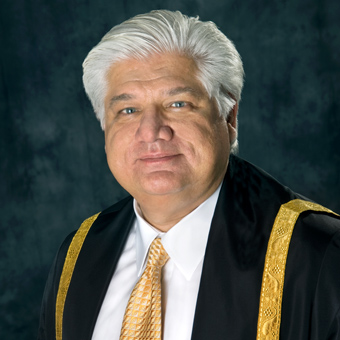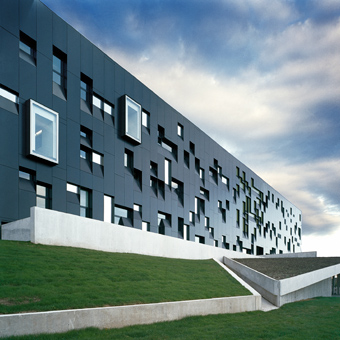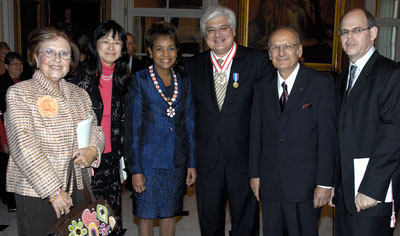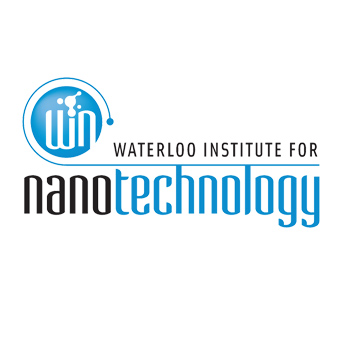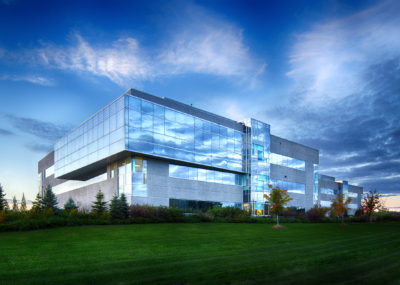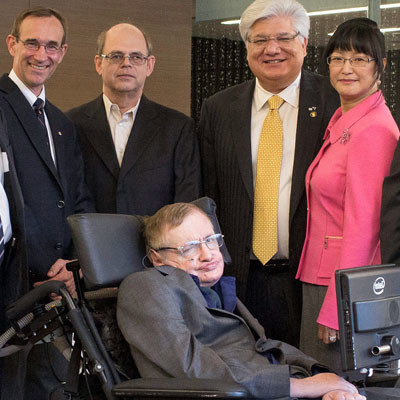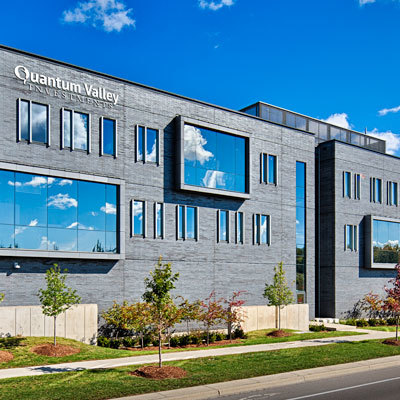-
1984
The Beginning of RIM
Two engineering students and childhood friends – Mike Lazaridis and Doug Fregin – co-found Research in Motion (RIM). The company was set up as an electronics and computer science consulting business based in Waterloo. Within four years, the company would discover the emerging wireless data market and pursue it with a passion.
-
1994
And the Emmy goes to…
Mike and Doug are awarded the Emmy Award for the development of DigiSync, a high-speed barcode reader for film.
-
1997
BlackBerry Blueprint
The same year that RIM is listed on the Toronto Stock Exchange as a publicly traded company, Mike puts down the idea for the BlackBerry itself. One night, working in his basement, he typed up a “white paper” titled “Success Lies in Paradox” and e-mailed it to his office. In the paper, he defines what becomes the first BlackBerry.
-
1998
And the Oscar goes to…
Mike receives a Science and Technical award from the Academy of Motion Picture Arts and Sciences in 1998 for DigiSync.
-
1999
First BlackBerry Device
The first BlackBerry, the BlackBerry 950 pager, is introduced by RIM. The company signs agreements with several companies including BellSouth Wireless, IBM and Rogers Cantel, to provide wireless service. It offered a six-line display and allowed secure e-mail and two-way paging. Users could also browse specially formatted pages that offered news, weather and stock market data. RIM is ranked as one of Canada’s fastest-growing technology companies.
-
2000
The Perimeter Institute Launches
Mike establishes the Perimeter Institute for Theoretical Physics, an independent theoretical physics research institute, in 2000. Initial funding of the Institute includes a pledge of $100 million from Mike (which at the time was approximately one third of his net worth) and $10 million from Doug.
-
2001
The Vision for IQC is Established
Mike convinces the University of Waterloo to establish the Institute for Quantum Computing (IQC) and to recruit Raymond Laflamme from Los Alamos National Laboratory to become its founding director. Dr. Laflamme also holds the position of associate researcher at Perimeter Institute.
-
2002
IQC Officially Opens
November 27, 2002 — IQC celebrates its official opening as a research institute housed in the University of Waterloo’s Physics building. Mike and Ophelia Lazaridis make their first personal donation of $3 million to help kick start research efforts at IQC. The contribution is matched by the Canadian Foundation for Innovation and the Ontario Innovation Trust.
Mike is named Canada’s Nation Builder of the Year, Globe and Mail
Mike is awarded Canada’s most prestigious innovation prize, The Ernest C. Manning Principal Award (which he shares with RIM colleague Gary Mousseau)
-
2003
Mike becomes University of Waterloo’s Chancellor
After being a long-standing member of the Board of Governors of the University of Waterloo, in May 2003, Mike is installed as its Chancellor. Mike served as UW Chancellor from 2003 until 2009.
-
2004
Further Support for Quantum Research
Mike and Ophelia Lazaridis make donation of $30.3 million (for a total of $33.3 million supported thus far). At Mike’s request and with Mike’s help, the University obtains 2 for 1 matching of the donation from various sources with the result that a total of $100 million is made available to IQC;
Doug pledges $4 million to the University of Waterloo in support of a new Nanotechnology initiative;
Perimeter Institute opens the doors of its first custom-built facility. The Governor-General award winning building was designed by Montreal-based Saucier + Perrotte, the 65,000-square-foot building houses Perimeter’s growing research, training and outreach community.
-
2005
Initial Funding for the Quantum Nano Centre
Mike and Ophelia Lazaridis donate more than $17 million to the University of Waterloo — $12.5 million of which serves as initial funding for Quantum Nano Centre construction;
Mike is named in the TIME 100 List of Most Influential People in 2005.
-
2006
National and Provincial Recognition
Mike is made an Officer of the Order of Canada and a member of the Order of Ontario. Both recognizing outstanding achievement, dedication to the community and service to the nation (and to the province of Ontario).
-
2007
Inspiring Further Funding for Quantum Research
Mike and Ophelia Lazaridis continue to support research at IQC with a pledge of $50 million. Leading by example, Mike convinces the Province of Ontario (2006) and Industry Canada (2009) to match his donation at $50 million each.
The official groundbreaking of the Mike & Ophelia Lazaridis Quantum-Nano Centre occurs.
Doug donates an additional $25 million to the University of Waterloo in further support of the University’s Nanotechnology initiative which funds were allocated as follows $10 million to the construction of QNC, $10.5 million toward fellowships toward the University’s new nanotechnology program, and $4.5 million toward chairs in Nanotechnology.
-
2008
Waterloo Institute for Nanotechnology is Established
With support of Doug (see 2004 and 2007), University of Waterloo establishes the Waterloo Institute for Nanotechnology (WIN). WIN establishes as an area of primary focus the intersection of nanotechnology and quantum physics.
Mike leads recruitment effort at Perimeter and is successful in hiring Dr. Neil Turok, renowned cosmologist from Cambridge University, to become its new Director.
-
2009
Further Support for Perimeter
Mike and Doug each donate a further $20 million to the Perimeter Institute.
-
2010
Research Advancement Center II
IQC expands into the Research Advancement Centre II (RACII) building — funded by IQC’s benefactors Mike Lazaridis and Doug Fregin.
-
2011
Stephen Hawking Centre Opens
In September 2011, doors open in the new Stephen Hawking Centre at Perimeter Institute, a new expansion to house Perimeter’s growing research, training, and outreach activities. The new centre doubles the square footage of the existing facility, while making room for triple the researchers. Prof. Stephen Hawking joined Perimeter Institute in 2008 as its first Distinguished Research Chair, a position that sees leading international scientists establish a second “research home” at Perimeter.
-
2012
Mike & Ophelia Lazaridis Quantum Nano Centre opens at UW
The Mike & Ophelia Lazaridis Quantum-Nano Centre officially opens and is shared by IQC, WIN and the Nanotechnology Engineering program. The state-of-the-art facility is built to the most stringent scientific controls against vibration, temperature fluctuations, electromagnetic radiation and more, enabling research and discovery at the forefront of science. An architectural marvel at the heart of the University of Waterloo campus, the building is creatively designed to spark conversation and collaboration between researchers from across disciplines, and attract the world’s top scientific minds to Waterloo.
-
2013
Quantum Valley Investments launches with The Quantum Valley Investment Fund
Mike and Doug launch Quantum Valley Investments, focusing on the commercialization of breakthrough technologies in Quantum Information Science. In doing so they are taking an essential next step in furtherance of their shared vision toward the development of the “Quantum Valley” in the Waterloo Region of Canada.
The Quantum Valley Investment Fund is created, a private fund established by and funded completely by Mike Lazaridis and Doug Fregin (the Managing Partners). The initial size of the Fund is $100 million (CDN). The Fund will provide commercialization funding, expertise and support for researchers that develop breakthroughs in Quantum Information Science that can reasonably lead to new commercializable technologies and applications.
-
2014
Quantum Valley Investments Expands its Facilities
Quantum Valley Investments introduces a new state-of-the-art building which will be the new home for high technology businesses supported by the Quantum Valley Investments Fund. The new facility adds to the 70,000 square foot Research Advancement Centre 2 (“RAC2”) currently occupied by Quantum Valley Investments which is a stone’s throw away in the University of Waterloo Research and Technology Park. RAC2 contains a complete suite of tools for the design, development and application of solid-state quantum devices. These include unique tools for materials science, low temperature physics including a first of its kind custom built Ultra-High Vacuum (UHV) quantum materials lab (the “Omicron”) owned by Institute for Quantum Computing (“IQC”).
Also, QVI is in the process of building four “Quiet Labs” at RAC2. At a projected cost of over $5.5 million, totally funded by QVI, the Quiet Labs includes vibration, acoustic, magnetic and electromagnetic ratings making them one of the first of their kind.”








